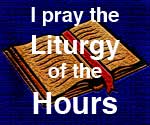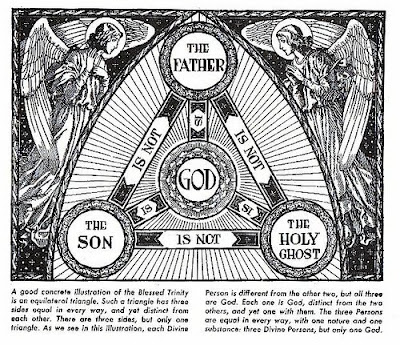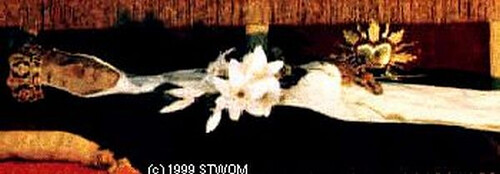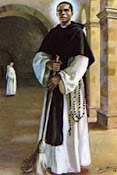 Despite what the graphic in the left column of this blog says, it is not true that I pray the Liturgy of the Hours (Divine Office). I haven't prayed the Rosary, Divine Office or any other prayer in over 3 weeks now. I simply can't seem to make myself pray anymore. I don't know how much longer this "fake [faith] it till you make" act in going through the other Church motions can continue. I'm going to have to fall off the fence soon; who knows which side I'm going to land.
Despite what the graphic in the left column of this blog says, it is not true that I pray the Liturgy of the Hours (Divine Office). I haven't prayed the Rosary, Divine Office or any other prayer in over 3 weeks now. I simply can't seem to make myself pray anymore. I don't know how much longer this "fake [faith] it till you make" act in going through the other Church motions can continue. I'm going to have to fall off the fence soon; who knows which side I'm going to land.Recent Posts
Thursday, November 4, 2010
Crisis of Faith Fake it 'Till You Make it.
 Despite what the graphic in the left column of this blog says, it is not true that I pray the Liturgy of the Hours (Divine Office). I haven't prayed the Rosary, Divine Office or any other prayer in over 3 weeks now. I simply can't seem to make myself pray anymore. I don't know how much longer this "fake [faith] it till you make" act in going through the other Church motions can continue. I'm going to have to fall off the fence soon; who knows which side I'm going to land.
Despite what the graphic in the left column of this blog says, it is not true that I pray the Liturgy of the Hours (Divine Office). I haven't prayed the Rosary, Divine Office or any other prayer in over 3 weeks now. I simply can't seem to make myself pray anymore. I don't know how much longer this "fake [faith] it till you make" act in going through the other Church motions can continue. I'm going to have to fall off the fence soon; who knows which side I'm going to land.Tuesday, August 17, 2010
Help is Full!
I'm totally dumbfounded that Catholic Charities in my diocese currently doesn't need volunteers! Apparently, other local Catholic orgs that want volunteers don't need them bad enough to return inquiry calls.
Thursday, August 5, 2010
Post Acute Myocardial Infraction Musings
As most of the post heart attack fear and stress is slowly fading, there is the new fear of what impact this may have on my now 7 year (this month) struggle for any type of ordination in the Church. I often wonder where my priorities are - as I lay there embarrassingly exposed while they did my cardiac catheterization, all I thought about the entire time was if and how there was a possibility this would prevent me from ever becoming a priest. I decided on the table not to give up on life even if the only dream I have can no longer remain just a hope.
I've been ignoring people too, but now it's time to move back into Creation. Moving on, let's see what business we can get down to with prayer, study, community and apostolate!
Brian.
Friday, July 9, 2010
Saint John of Cologne
 Today we remember the Dominican martyr St. John of Cologne and the other 18 Martyrs of Gorkum, all priests and religious.
Today we remember the Dominican martyr St. John of Cologne and the other 18 Martyrs of Gorkum, all priests and religious.Previous to his martyrdom, all that we know of the life of St. John of Gorkum can be quickly told. He was a religious of his convent of Cologne who performed the duties of a parish priest in Holland, which was at that time engaged in a death struggle with the Spanish princes. The place and date of his birth are not known; those of his death will never be forgotten.
Anti Spanish and Protestant soldiers banded themselves into lawless armies of pirates, and, unpaid and disillusioned, foraged for themselves in the seaports, looking for plunder. Reproached by the clergy, they turned on the Church and one band of pirates laid siege to the city of Gorkum, capturing it after a struggle. For reprisal because of the city's determined defense they gathered all members of the clergy in Gorkum into one miserable prison and set about taking revenge on the priests for their own grievances against the Spanish crown. Hearing of the plight of these poor priests, John left the comparative safety of his parish and entered Gorkum in disguise in order to give whatever assistance he might. Several times he entered the city to dispense the sacraments, and to bring consolation to the priests who were being cruelly tortured. Eventually, he also was taken prisoner and subjected to torture.
Angered by the endurance of the priests, the pirates increased their abuses. Some of the religious were very old and infirm, but one and all, even to an aged Augustinian who was so weak he could barely stand, they bore their martyrdom with patience and sweetness for ten terrible days and nights. They were repeatedly asked to deny the Real Presence, and just as repeatedly refused, which brought on more and more dreadful tortures. Finally they were thrown into the hold of a ship, and they were taken to another city to be killed in the presence of a Protestant nobleman, a man noted for his hatred of Catholicism.
Eleven Franciscans, a Premonstratensian, an Augustinian and four secular priests suffered with John of Cologne the long anguish of protracted martyrdom. Two of the number had been far from exemplary in their lives, but by their heroic constancy at the hour of trial blotted out the stains that might otherwise have kept them out of heaven. But, sadly, there should have been twenty martyrs of Gorkum. One, who weakened and was released after he had denied the Real Presence, lived but twenty four hours to enjoy his wretched freedom. The other nineteen gloriously went to heaven.
The martyrs, after being exhibited to the curious townspeople (who paid to see the spectacle) and subjected to every manner of torture, were finally hanged in an old barn, amid the jeers of the mob. Stripped of their habits and made, like their Master, "the reproach of men and the outcast of the people," they benefitted by their Christ like sufferings and detachment and died a Christ like death.
Their bodies, mutilated both before and after death, were callously thrown into a ditch.
The scene of their martyrdom soon became a place of pilgrimage, where all the Christian world did reverence to the men who were so courageously obedient unto death. Accounts of several miracles, performed through the martyrs’ intercession and relics, were used for their beatification. Most of their relics are kept in the Franciscan church at Brussels to which they were secretly conveyed from Briel in 1616.
(Source : Dorcy, Marie Jean. St. Dominic's Family. Tan Books and Publishers, 1983, The Order of Preachers)
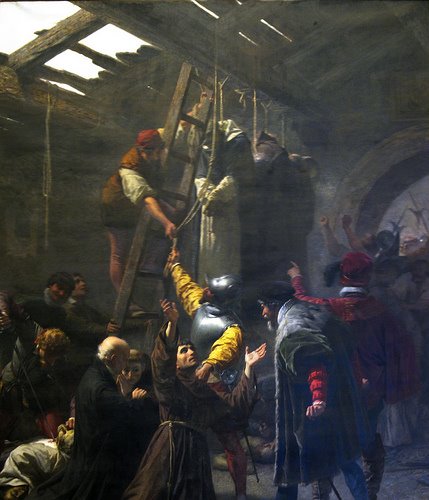
Painting depicting the Martyrs of Gorkum
Wednesday, June 30, 2010
Saint Vihn Son Ðo Yen (St. Vincent Yen)
 Today we remember St. Vincent Yen, one of the Martyrs of Vietnam, individually. The following is from Witnesses of the Faith in the Orient, Dominican Martyrs of Japan, China, and Vietnam translated by Sister Maria Maez, O.P.
Today we remember St. Vincent Yen, one of the Martyrs of Vietnam, individually. The following is from Witnesses of the Faith in the Orient, Dominican Martyrs of Japan, China, and Vietnam translated by Sister Maria Maez, O.P.This holy martyr was born in Tra-lu in the province of Nam-dinh in 1764. He was trained under the supervision of Bishop Ignatius Delgado, who ordained him a priest at the age of 40. He was appointed to the care of souls. His Calvary began right away. He was secretly denounced to the Mandarins, taken prisoner and made to carry a heavy cangue [yoke]. He spent a month in this condition until he was rescued by friends.
Vincent asked to be admitted to the Dominican Order and received the habit on 22 July 1807. His purity and considerate treatment of others was such that he won everyone’s respect. “His eyes, his whole facial expression was an eloquent testimony of his holiness.” Even the enemies who captured him remarked that they had taken a prisoner who “was a man with a most beautiful countenance.” It was no wonder that he was able to win over all those entrusted to his care.
Vincent was once again imprisoned on 8 June 1838; on the 11th, the Mandarins came together to judge him. The leading Mandarin, a good man of means and influence, resisted imposing the death sentence. He proposed to Father Yen to say that he was a doctor, not a priest. Vincent rejecterd this outright, saying: “I am not a doctor, I am a priest. My office is to offer sacrifices to God and to preach the faith of Jesus Christ for whom I am ready to die. I do not accept the offer for the price of a lie.” Seeing the constancy of the priest, they took the message to the Emperor, who dictated the sentence himself. “Do Yen, native of this Kingdom, principal teacher of the Religion of Jesus Christ, has followed a false religion and does not wish to abandon it. He is truly a dangerous fool and is deserving of suffering any abomination, because he does not wish to follow what he knows and what he should do. Let his head be cut off.”
The venerable old man of 74 walked erectly, calmly and with joy to his execution on 30 June 1838. He was beheaded for being a priest of the Religion and for teaching it to the people.
The Process of Beatification says that Vincent had a most gentle disposition, a happy face and limitless mercy, — that he was prudent, peaceful, very virtuous and that his life had been an edification to all.
Monday, June 14, 2010
Saint Basil the Great
 Today is the feast of the eminent Church Father and Doctor, St. Basil, according to the Extraordinary Calendar of the Latin/Western rite. He is only one of four saints given the designation of Great and the only one that was not a pope!
Today is the feast of the eminent Church Father and Doctor, St. Basil, according to the Extraordinary Calendar of the Latin/Western rite. He is only one of four saints given the designation of Great and the only one that was not a pope!A great saint such as he has been well profiled and the sources about him are myriad. There is no need to "reinvent the wheel" here and give an underserving, poor summary of this great man of God. To learn more about him, start at the online Catholic Encyclopedia or the Patron Saints Index.
Prayer of St. Basil After Communion
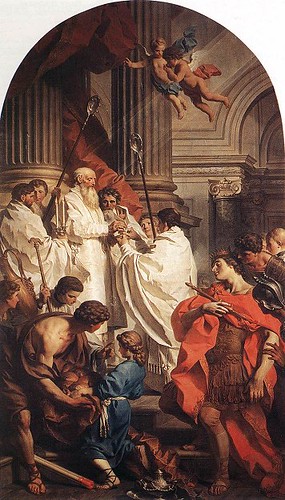
Mass of St. Basil by Pierre Subleyras
O sinner, be not discouraged, but have recourse to Mary in all you necessities. Call her to your assistance, for such is the divine Will that she should help in every kind of necessity. --St. Basil the Great
Let us raise ourselves from our fall and not give up hope as long as we are free from sin. Jesus Christ came into this world to save sinners. "Come, let us adore and prostrate ourselves and weep before him" (Psalm 95:6). The Word calls us to repentance, crying out: "Come to me, all you who labor and are heavily burdened and I will refresh you" (Matthew 11:28). There is, then, a way to salvation if we are willing to follow it. --from a letter of St. Basil's

Saturday, June 12, 2010
Blessed Stephen Bandelli
Stephen earned a degree in canon law and a master's degree in theology, and lectured at the University of Pavia. He was a man of superior intellect and a careful student. Tradition holds that he was "another Saint Paul," and that his sermons were effective in bringing many Christians to a more fervent life and many sinners back into the fold. Aside from this, one reads only the traditional assurances--that he was prayerful, penitential, had a spirit of poverty, was charitable, and was a model religious.
When Stephen died, he was buried in the Dominican church of Saluzzo. Many miracles were worked at his tomb, and the citizens of Saluzzo invoked him, in 1487, when the town was attacked by one of their neighbors. Their preservation was attributed to Stephen's intercession, as it was claimed that he had appeared in the sky above them while they were fighting. An annual feast was kept there in his honor for many years (Benedictines, Dorcy). source
Prayer
O God who, to recall the erring faithful to the way of salvation, didst make Blessed Stephen, Thy Confessor, an illustrious preacher of the Gospel, grant through his merits and intercession, that being freed from all sin we may ever run in the path of Thy commandments. Through Christ our Lord. Amen.
Friday, June 11, 2010
Poem "To The Sacred Heart"
TO THE SACRED HEART
Edwin Anoelo Leman
I my heart have oft times given
..To the creature, but in vain;
Cold repulse has swiftly driven
..Back my thoughts to Thee again.
I discerned that Thou wert jealous,
..Even of such love as mine,
And wouldst have me to be zealous
..Only for Thy Heart Divine.

Tuesday, June 8, 2010
Bl. Diana, Bl. Cecilia, Bl. Amata
The marvelous cloistered nuns were the first branch of our Dominican family! Bl. Diana & Bl. Cecilia is among the earliest and both knew St. Dominic.
Both came from noble families of note: Bl. Diana's family were powerful nobles in Bologna (with her former title of Lady Diana) while Bl. Cecilia came from the ancient Caesarini noble family of Rome.
Bl. Diana was both beautiful and spoiled. Her life changed when she heard Blessed Reginald of Orleans preach. Becoming enamored with the Dominicans, she longed to start a life as a member of the new order but her family was firmly opposed. Meeting St. Dominic when he stopped in Bologna, she obtained his permission to start a community of sisters, with St. Dominic, himself, putting four of the brothers in that local community under obedience to assist the building of her convent. It wasn’t until after the death of St. Dominic that Bl. Diana was able to overcome the forceful resistance of her family not allowing her to enter religious life. Having a great correspondence with Blessed Jordan of Saxony, the Monastery of St. Agnes was built and she entered in 1223 and was its first prioress.
Bl. Cecilia was the youngest nun in the Benedictine monastery of Santa Maria in Tempulo when St. Dominic was founding the Monastery of St. Sixtus in 1220. The Monastery of St. Sixtus was founded by combining various female communities with Bl. Cecilia’s being among them. She received the Dominican habit from St. Dominic. About 1223, she and some others sisters were sent to Bl. Diana’s new Monastery of St. Agnes. Bl. Cecilia became the new prioress.
From both of these blessed we have a fantastic legacy. Through Bl. Diana’s letters are long lost, she kept all her letters from Bl. Jordan of Saxony, giving us great insights to the early days of the Dominican family as well as both BB Jordan and Diana. Bl. Cecilia left us the only physical description we have of St. Dominic! Both women remained at the Monastery of St. Agnes for the remainder of their earthly lives.
Not to be forgotten is Blessed Amata. She was a nun at St. Sixtus with Bl. Cecilia also receiving the habit from St. Dominic. She was beatified in 1891 with Diana and Cecilia but was not included on the calendar because so little is known of her.
The book, St. Dominic's Family by Sr. Mary Jean Dorcy, O.P writes this about her:
Of Sister Amata, we know practically nothing, but that she was a good friend of St. Dominic, which should, after all, be enough to know about anybody. He, according to legend, gave her the name Amata--which means 'beloved'--and very probably he either sent her to the convent in the first place or was the means of her staying there at the time of the drastic reforms, when the nuns left St. Mary's trans Tiber and went to S. Sixtus. There was a Sister Amata from whom St. Dominic is said to have cast out seven devils, but it could hardly have been this one. The facts that he personally named her, and that she is buried with the other two, will have to be her title to honor.

Bl. Cecilia, Bl Diana, Bl. Amata
Let us pray:
Merciful Lord, we welcome in joy the feast of Blessed Diana and Blessed Cecilia. With the help of their prayers may devotion to truth and love for our brothers and sisters fill our hearts and our lives. Through Christ our Lord. Amen.
Friday, June 4, 2010
Saint Peter the Martyr
The Dominican Ordo for 2010 designates today as his memorial. His feast on the Extraordinary Calendar is 29 April. St. Catherine of Siena died on 29 April but was given the 30th because St. Peter the Martyr already had the 29th. In the “reformed” 1969 calendar, St. Peter the Martyr was bumped off the calendar by St. Catherine as she was moved back by one day.
St. Peter was born 1205 or 1206. The fact that he was born to parents that were heretical Cathars is proof of his divine love for truth and Orthodoxy. In such an atmosphere where his own family ridiculed his orthodoxy, his life was destined to be sacrificed for the faith!
He received the Dominican habit from St. Dominic, himself. He was a mystic that was visited by saints and angels, a gift for which he had to do penance for. On one occasion having celestial visitors in his cell, a passing monk heard female voices coming from his room. This led to his being accused of admitting females within the enclosure, to the great scandal of the house. The Saint said not a word in his own justification, but humbly accepted the severe penance imposed on him.
He became a very active and noted preacher in Northern Italy. His sermons were often complemented by miraculous signs of all kinds including casting out devils and healing the sick. Every day at the elevation of the Mass St. Peter prayed, Grant, Lord, that I may die for Thee, who for me didst die.
Pope Innocent IV made him inquisitor of Lombardy in 1232. It is said that wherever he appeared there was universal renunciation of errors and heresies. So great was his success to bringing those in error back to the Church that it’s no wonder the wrath of heretics was so violent towards him. He was attacked by assassins on the road between Milan and Como in 1252. His martyrdom had been mystically revealed to him and he approached happily. One of his assassins was so affected by the saint’s holy martyrdom that he entered the Order of Preachers, himself, and remained for forty years.
Saint Peter was canonized by Pope Innocent IV in the piazza outside the Dominican Church at Perugia, less than a year after his martyrdom.
Prayer
Grant, we beseech Thee, Almighty God, that we may imitate with due devotion the faith of Blessed Peter, Thy Martyr, who, for the extension of that same faith, was made worthy to obtain the palm of martyrdom. Through Christ our Lord. Amen.
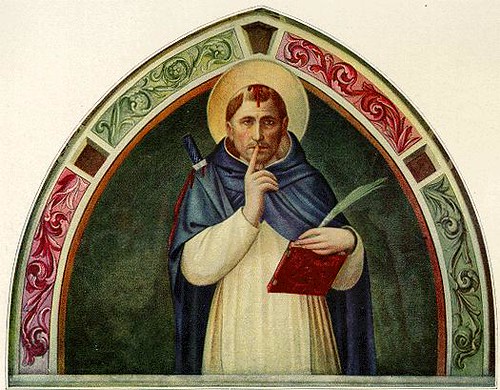
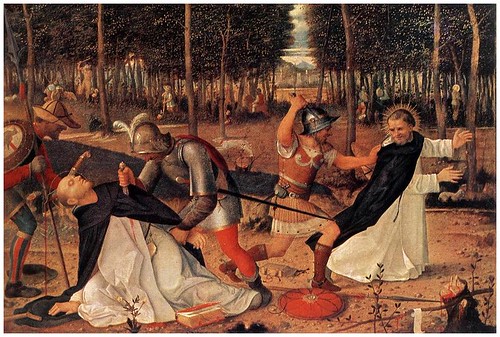
Monday, May 31, 2010
The Queenship of Mary
Feast of the Queenship of Mary!

Pray for us, O holy Mother of God…that we may be made worthy of the promises of Christ.
Sunday, May 30, 2010
Blessed Andrew Franchi, B.C.O.P
He was born in Pistoia, Italy, in 1335 and came from a noble family. He entered the Dominican order at the age of 14. He was in the order during the time of the Black Death and worked to bring back regular observance after the plague. He had served as prior in three different convents while still a young age.
As bishop of Pistoia, he was known for his preaching and austerity. He was a preacher of peace, devoted himself to the poor, and known for his devotion to the Infant Jesus, Mary, and the Three Kings.
He died 1401 and was declared Blessed by Pope Benedict XV in 1921.
He is one of the incorruptables!
Trinity Sunday
Wednesday, May 26, 2010
Fr. Aidan Nichols, OP on Liturgy
Thanks (said sarcastically) to one of my good friends, an Orthodox priest, a new personal phase of Fr. Aidan Nichols has entered my head.
Here's a great comment on the Liturgy he made during an interview.
Q. So you would see the Liturgy as playing a key role in divesting people of false ideas, especially in the Church?
A. Yes. It has to be Scripture and the Liturgy. Of course, the Liturgy is where Scripture, in a sense, comes most fully into its own, in the liturgical preaching and in the way in which the Liturgy is textured out of myriad biblical references.
But it has to be Liturgy that is not denatured so that it simply becomes an instrument of political correctness. Because in that case you’re losing precisely its power to challenge and transform the way people are when they arrive. If the function of the Liturgy is simply to affirm people in their secular identities or those aspects of decent living that are available through secular agencies, then I don’t see the Liturgy as having any special evangelical force. It must lift people up to something beyond their secular consciousness.
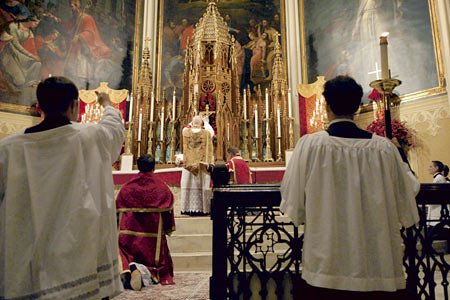
Monday, May 24, 2010
Translation of the body of our Holy Father St. Dominic
 24 May is the day the Order celebrates the feast of the translation of the body of St. Dominic.
24 May is the day the Order celebrates the feast of the translation of the body of St. Dominic.By the urging of the Saint, himself, Dominic was given a simple burial in an unadorned church tomb, being placed in a simple wooden coffin. Although it was attested that "no spices or aromatical perfumes of any kind were placed therein," the spot very soon afterward began emanating a "sweet and penetrating perfume" filled the church. Miracles also followed and continuously increased.
Despite the discouragement of St. Dominic's friar brethren, the translation of his body to a new coffin for interment in a new tomb took place 12 years after his death on 24 May. When the flagstone of his simple tomb was removed, the strong perfumed aroma filled the entire church. It was during this event that another miracle took place:
Tradition says that during the translation of the relics of Saint Dominic de Guzman 1267, when the body was exposed to view, the head was seen to turn towards Blessed John [Vercelli]. Embarrassed, John moved to another part of the church, giving his place to a cardinal. The head of Saint Dominic was seen by all to turn again toward John.
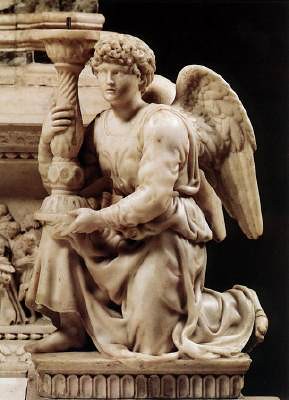
One of the angel candleholders by Michelangeo at St. Dominic's tomb
MEMORARE TO ST. DOMINIC
REMEMBER, O most dear and holy Father St. Dominic, that, at the close of thy mortal career, thou didst raise thy pure hands to heaven and pray:
"Holy Father, since by thy mercy I have ever accomplished thy will, and have kept and preserved those whom thou hast given to me, now I recommend them to thee : do thou keep them, do thou preserve them." Animated with unbounded confidence in thee. O tender Father, I cast myself at thy feet, beseeching thee to plead still for thy poor helpless children, to protect us amidst the dangers of om- earthly pilgrimage, to guard and keep us. Be mindful, O great Father, of the comforting assurance thou didst make in thy last moments to thy weeping brethren, promising that after death thou wouldst assist thy children. O Father, fulfil thy word, and help us by thy prayers.

The Ark of St. Dominic in Bologna, Italy
Sunday, May 23, 2010
Pentecost Sunday - Suggestions
or this
Strongly discourage (except for entertainment)
and
Hymn to the Holy Spirit
O Fire, Spirit, Comforter, life of the life of all creation!
Holy are you, bringing thought alive in flesh.
Holy are you, anointing the lost and broken.
Holy are you, healing infected wounds.
O sacred breath, O loving fire,
O sweetness in the breast
and flooding of the heart with the fragrance of goodness.
O clearest spring in which it is seen
that God gathers in strangers and seeks the lost.
O breastplate of life and hope for the unity of all the members,
O sword-belt of honor:
Save the blessed.
Protect those who are imprisoned by the enemy.
Set them free! Divine power wants to save them.
O most mighty way, you are everywhere
—in the heights and on the earth and in all the depths.
You gather and reconcile all people.
Clouds flow from you, skies fly, stones take in moisture,
Rivers of water overflow and drench the earth in living green.
You continually teach scholars who rejoice in Wisdom's gifts.
Therefore, praise be to you!
You yourself are the sound of praise and the joy of life,
You are hope and the most powerful grace,
Giving the gift of life.
- Hildegard of Bingen (translation by Ellen Oak)
Saturday, May 22, 2010
Saint Servatius
 Today the Order of Preachers remembers the feast day of Saint Servatius according to the Extraordinary Calendar. He was declared protector of the order in the 14th century.
Today the Order of Preachers remembers the feast day of Saint Servatius according to the Extraordinary Calendar. He was declared protector of the order in the 14th century. "In the fourteenth century the Church and the Order of Preachers were suffering bitter persecution from the schismatical Emperor, Lewis of Bavaria. Learning that the General Chapter was convoked to meet in his dominions , at the city of Cologne, 1330, A.D., this prince secretly plotted the death of the capitular Fathers. They had just assembled, when Saint Servatius appeared in a dream to one of their number, a very holy religious, warned him of the danger which threatened himself and his brethren , and bade them to flee to Maestricht. This they accordingly did, thus escaping the snares which had been laid for them. And though their coming to Maestricht was wholly unexpected, God disposed the hearts of the inhabitants to receive them with the utmost kindness."
Graciously hear these our prayers, we beseech Thee, O Lord, while we offer to Thee in this soleminity of Blessed Servatius, Thy Confessor and Bishop, that as he deserved to do Thee worthy service, so, through his merits and intercession, Thou wouldst mercifully absolve us from all our sins. Through Christ our Lord. Amen.
Text and Prayer: A Sister of the Congregation of St. Catherine of Siena (1909). Short Lives of the Dominican Saints. London, United Kingdom: Kegan Paul, Trench, Trubner & CO. LTD. Now in public domain.
Friday, May 21, 2010
The News That Hurts
Continuing proof that too many of today, particularly those that claim to be Catholic, no longer have any sense of the sacred: the Rainbow Sash homosexual movement announced plans to disrupt mass this coming Pentecost Sunday.
Have your say or object to whatever you please but in the proper venue! If they actually were the deserving Catholics they claim to be, they would never disrupt the Church's most sacred rite.
One can't help but be confused by the recent public comments from a Jesuit about some of Pope Benedict XVI's words to social workers during an audience with them in Portugal.
To quote Fr. James Martin, S.J., ...he [The Pope] stated that abortion and same-sex marriage, were "some of today's most insidious and dangerous threats" to the common good seemed oddly discordant. The equation of abortion, something that clearly is about a threat to life, with same-sex marriage, which no matter how you look at it, does not mean that anyone is going to die, is bizarre.
Beyond the fact that too many contemporary Jesuits are incapable of defending the Pope (no surprise), one would expect a magazine editor of America to correctly interpret a simple statement in context of Catholic teaching. Nowhere does the Holy Father equate abortion to same-sex marriage as the same thing materially. They are mentioned as two distinct evils that are equally dangerous (and murderous) spiritually.
Edited out the article was the fact that Fr. Martin went as far as to say that the Pope's statement went against the Gospel!
It's only a personal perception but is seems the recent meeting of 800 women religious leaders in Rome was failed damage control for the recent "inquisition" of the U.S. Apostolic Visitation. They released a declaration using their best "Spirit of Vatican II" newspeak (which has nothing to do with the true Vatican II). I suggest reading the declaration and commentary over at the Acts of the Apostasy blog. You must play the optional accompanied music for the best effect!
Don't get me started on the son-of-a-lesbian-couple-attending-Catholic-school fiasco in the Archdiocese of Boston.
Wednesday, May 5, 2010
Mother Seton Prays Fervently
Seton Hall is the oldest DIOCESAN University in the country and is under the Archdiocese of Newark. Therefore it is under the Catholic teaching of the archbishop. The university, itself, publically self-identifies as a Catholic institution and states, "A university is Catholic in many ways: ...living Catholic values." The university is obligated to uphold Catholic teaching by its own declaration while the archbishop is doing his job as the primary teacher and sanctifier for his see.
Even if it wasn't a diocesan establishment, as a Catholic institution it requires a "professio fidei" under canon 833 of the current Canon Law. In the revised code of 1983, a "professio fidei" was extended to theologians and others who teach in faith and ethics "in any [Catholic] universities whatsoever" as well as priests, bishops, etc.
A "same-sex marriage course" at a Catholic college is not a bad thing in itself. However, if such a course is to be taught, it should be solely from the spiritual teaching of the Church.
If it were truly from an "academic perspective" or some people believe Seton Hall should adhere to their personal interpretation of a "'real' open academic institution," then the expectation should also be for a "'real' open academic" lecturer. The class professor, W. King Mott, is an openly homosexual man in a same-sex relationship; he called the Catholic Church "prima facie homophobic" and has publically stated Church teaching on marriage being between one man and one woman as "laughable." This is hardly an "open academic" situation. Sounds rather biased to me.
It's easy for modernist academics to put a chosen spin on Bible passages despite 2000 years of previous teaching descended from others much closer to the time. But let's not also forget that there was no word or concept to fully convey our current understanding of what we now call "homosexual."
There are a lot of things Jesus never mentioned! (He DID refer to the sins of Sodom and Gomorrah, though.) You would have to disregard then entire New Testament save for the four Gospels if you “cherry-pick” to only believe something because "Jesus said it."
Tuesday, April 20, 2010
Saint Agnes of Montepulciano
After her years at Procena the people Montepulciano requested her to establish a monastery. St. Agnes was unsure which rule to adhere in starting the new monastery, so she prayed and received her answer in a vision. From her vision of St. Augustine, St. Francis and St. Dominic she knew she was to begin a new community of woman according to the rule of St. Dominic. St. Dominic made known to her she was to start a community of virgins at Montepulciano on a hill which previously had the site of brothels.
It is said she was granted a warning of her purgatory before going to Heaven and mystical experiences on many consecutive Sundays when, shortly afterwards, she began her painful terminal illness.
Her sisters took her to the medicinal baths at Chianciano but they did not help her. However, while she was there, a miraculous hot water spring gushed (later named for her) and she miraculously brought a child back to life that had drowned there.
St. Agnes died when she was 49.
Another great female Dominican saint, St. Catherine if Siena, made a famous pilgrimage to St. Agnes’ tomb. St. Agnes’ incorrupt body lifted her foot for St. Catherine to kiss. St. Agnes was canonized AD 1726.
Let us pray...
O God who was ofttimes pleased to shed a heavenly dew over Thy Holy Virgin, Blessed Agnes, and to deck the places of her prayer with divers fresh blown flowers, mercifully grant that we, through her prayers, may be sprinkled with the unfailing dew of Thy blessing, and made fit to receive the fruits of immortality.
Through Christ our Lord. Amen.
The incorrupt body of St. Agnes
Friday, March 19, 2010
3rd Annual Catholic Men's National Day of Prayer
 Today is the 3rd annual Men's National Day of Prayer.
Today is the 3rd annual Men's National Day of Prayer. - For every man to heed Christ's call to personal conversion.
- For every man to become a transformed disciple of Jesus.
- For every Catholic man to fully actualize his vocational state of life calling.
- For every married man to love his wife and children as Christ loved the Church.
- For every ordained and religious man to serve Christ and His Church in accord with his specific vocation.
- For every man to embrace, proclaim and exemplify the truth of the Gospel in his home, parish, workplace and community.
Uh Oh, I'm Back
Wednesday, January 6, 2010
Pax et fides

St. St. Dominic dedicated himself to promoting "pax et fides", "peace and faith", because without peace, the faith cannot flourish, and he described himself as pursuing this goal by "singing and gentleness, preaching, imploring and weeping" (cf. M.-H. Vicaire, O.P., St. Dominic and His Times, pp. 62 and nt. 7, 146, 147 and nt. 80)."
Sunday, January 3, 2010
Saint Zdislava of Lemberk

Born of a warrior race to noble parents, Zedislava lived in a fortified castle on the borders of Christendom, in an age when the fierce Mongol hordes were the world's worst menace. Her whole life was spent within the sound of clashing arms, and the moans of the dying. The gentleness and purity of her life stand out in surprising beauty against the dark background of a warlike and materialistic people.
Zedislava learned Christian charity early in life from her mother, who taught her not only the secrets of preparing medicinal herbs but also the healing balm of prayer. Going each day to the castle gate with alms and medicines for the poor and the wretched who crowded there for help, she was soon well acquainted with human misery. Cheerful, prayerful, and alert to see the sorrows of others, the child became a light of hope to the miserable. Because of her sweetness and natural charm, she was able to teach many lessons to those about her.

As a child, she is said to have fled from her home for a time to live as a hermit, but she returned to live a more normal life that included an early marriage to a soldier, the duke of Lemmberk, who, like her own father, was a rich nobleman in command of a castle on the frontier. The couple produced four children. Zedislava cared judiciously for her own family and lavished great care on the poor, especially the fugitives and victims of the Tartar invasions.
Her husband was a good man, but a rough and battle-hardened soldier who liked nothing better than the clash of swords. He may have treated Zedislava badly and he certainly tried his young wife's patience and obedience in a thousand ways. He insisted that she dress in her finest gowns and attend the long and barbarous banquets that pleased him so. (In return, she tried his patience because of her generosity towards the poor.)
Being of a retiring disposition and much given to prayer--and, moreover, having a family and a large castle to care for--she found this a real sacrifice. However, obedience and patience had been an important part of her training, and she taught herself to spiritualize the endless trials that would beset the mother of four children in a medieval fortress.
The Polish missionaries, Saint Hyacinth and Blessed Ceslaus, brought Zedislava the first knowledge of the new religious order which had begun but a few years before. Saint Dominic, a Spaniard, had met them in Italy, where he had gone to have his order approved. Begun in France, the Dominican Order was already international, and with the profession of Zedislava as the first Slavic Tertiary, its world-wide scope became apparent.
Enchanted with the possibilities of an order that allowed her to share in its benefits and works while caring for her family, Zedislava threw herself into the new project with enviable zeal. She encouraged her husband to build a hostel for the many poor pilgrims who came homeless to the gate. She visited the prisoners in the frightful dungeons, and used her influence to obtain pardons from the severe sentences meted out to them. She fed and cared for the poor, taught catechism to the children of the servants, and showed all, by the sweetness of her life, just what it meant to be a Christian lady and a Dominican Tertiary. On the occasion of a Mongol (Tartar) attack, when homeless refugees poured into the castle stronghold, her calm, invincible charity was a bulwark of strength to all.
With her own funds, Zedislava determined to build a church (Priory of Saint Lawrence) where God might be fittingly worshipped. As an act of zeal and penance, she herself carried many of the heavy beams and materials that went into the building. She did this at night so that no one would know of her hard work. Zedislava experienced visions and ecstasies during this time. She also received Holy Communion nearly every day in an age when this was not customary.
Her death came soon after the completion of the church. The mourning people who knelt by her deathbed could see evidence of her strong Christian virtues in the monuments she had left: her children, her church, and the inspiration of a saintly wife and mother. She consoled her husband in life and appeared to him in glory after death, which strongly encouraged his desire for conversion. Numerous miracles are ascribed to Saint Zedislava, including the raising of the dead to life, though Pope Pius X did not refer to these in his approval of the cultus given to her in her native country (Benedictines, Dorcy, Farmer).

Saturday, January 2, 2010
First Saturday January

Mary is the most sweet bait, chosen, prepared, and ordained by God, to catch the hearts of men. -- St. Catherine of Siena


